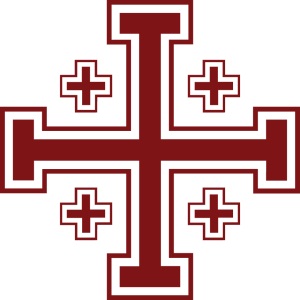Jerusalem Cross
May 21, 2016 3:28 am As I meet and talk with people, I am frequently asked about one of the graphic logos that we use on our website, business cards, and marketing material. I’m referring to the Jerusalem Cross.
As I meet and talk with people, I am frequently asked about one of the graphic logos that we use on our website, business cards, and marketing material. I’m referring to the Jerusalem Cross.
I thought it might be interesting to share our reasons for incorporating this powerful symbol into our company’s persona.
1. Design
From the perspective of design, the Jerusalem Cross, with its many angles, and in this case, its bright red color, is visually arresting, intriguing, and memorable. For those familiar with the Catholic faith, or history at least, it immediately communicates that here is something linked to Christ.
2. History
The Jerusalem Cross is often called the Crusader’s Cross because it was on the papal banner given to the crusaders by Pope Urban II at the start of the First Crusade in 1095. Pope Urban II wished the people of Europe to make a pilgrimage to the Holy Land. This turned into a Crusade to liberate all of the Churches in the “East”, meaning present day Turkey east of the Bosporus, Syria, Lebanon, Palestine, and Israel. These lands had all fallen to invasions by the Seljuk Turks, who closed, desecrated, converted, or destroyed the Churches in those lands.
The Pope was responding to a request from the Byzantine Emperor for help in repelling the advancing Turks. The first Crusade ended with the retaking of Jerusalem by the Crusaders. Even today, if you travel through Israel, you will find, here and there, white flags flying that are emblazoned with the Jerusalem Cross, as they have for over a thousand years.
3. Meaning
There are various interpretations of the meaning of the Jerusalem Cross. Some believe that it represents Christ’s command to spread the Gospel around the world; a mission that started in Jerusalem which is represented by the large, center cross. In this interpretation, the four small crosses represent the four corners of the world, to which the good news of the Gospel was to be preached.
Some see it as representing the Bible, with the Old Testament in the four Tau Crosses, the T’s that make up the center cross, and the New Testament’s four gospels in the smaller crosses.
Or, the main cross may represent the idea of Christ in the center of everything, surrounded by the four evangelists; Matthew, Mark, Luke, and John.
It may be that the Jerusalem cross graphically depicts the five wounds suffered by Jesus during Calvary. The four small crosses being the piercing by the nails of His hands and feet and the large central cross the spear wound in Jesus’ side.
Lastly, some Christians in Jerusalem refer to this symbol as the Pilgrim’s Cross. In this tradition, the middle cross is the pilgrim, with the smaller crosses being those who support and pray for the pilgrim during his/her pilgrimage. Recall that the 1st Crusade began as a pilgrimage to the Holy Land.
Whichever interpretation of the Jerusalem Cross you favor, the undeniable fact is that it is a potent symbol of the “Church militant”, where that term means the faithful here on earth who are struggling against sin, the devil, and “the rulers of darkness of this world, against spiritual wickedness in high places” (Ephesians 6:12).
4. In Conclusion
In the Jerusalem Cross we find much of what inspires us. At Summit, we are on a crusade (small “C” intentional) to bring Catholic investors not only solid investment approaches that can lead to financial success, but investment approaches that combine those traits with the Catholic faith. The US Conference of Catholic Bishops has published socially responsible investment guidelines to help investors adhere to the tenets of Catholicism. One of the prescriptions of the guidelines is to engage in active advocacy (or to “struggle against spiritual wickedness in high places”) to bring about change for moral improvement in those companies which have stepped over certain moral boundaries but that, nonetheless, may be receptive to the possibility of change. We believe that by providing active advocacy to our investors’ portfolios, together we can help to create a better, more moral, country and world.
Jesus contrasted his way to the way of the world quite emphatically: “He who is not with me is against me” (Luke 11:23). St. Ignatius of Loyola (the founder of the Society of Jesus, the Jesuits) developed this into his “A Meditation on the Two Standards”—a “standard” meaning a flag.
In that meditation, St. Ignatius tells us that we have to choose where we are going to stand; with Jesus under His standard or with Satan under his. No matter who we are, once we are baptized and confirmed, we are called to stand with Jesus’ under his flag. We start to join Jesus when we accept that everything we have is a gift from God. Once that truth has been grasped, we see the way through Satan’s traps and become focused on the question: “How can I help?”
We at Summit are committed to Jesus’ standard and to helping. Won’t you join us?
Contact our financial advisors for a free consultation on investing in accord with the USCCB guidelines.
Post from: Insights

